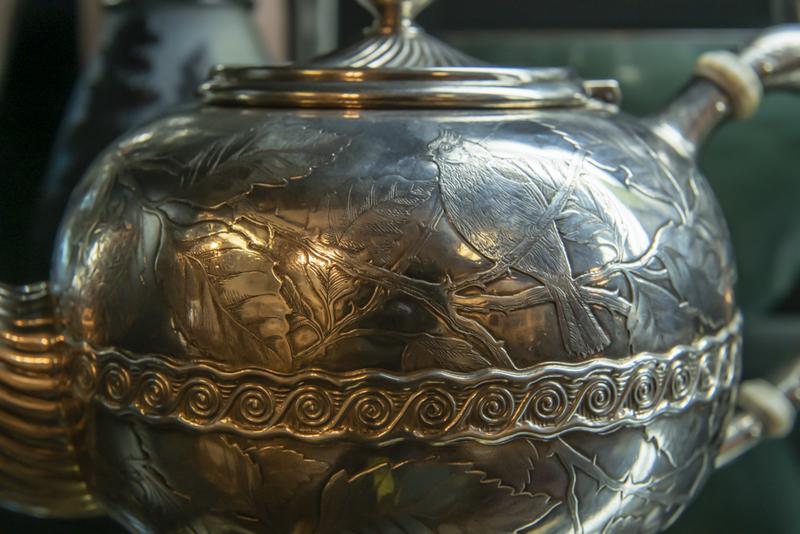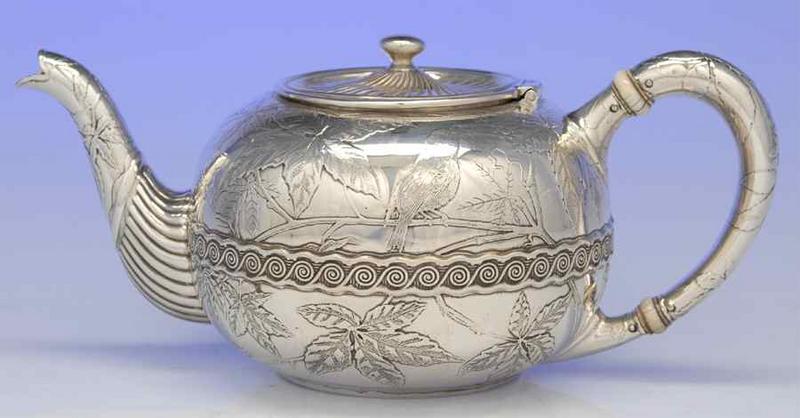Page 1 of 1
Gorham question
Posted: Tue Jun 18, 2019 6:50 pm
by blueheron
Re: Gorham question
Posted: Wed Jun 19, 2019 11:25 am
by MsJMoody
Do you have a close up of the date mark? It is hard to see it with the images provided.
Re: Gorham question
Posted: Wed Jun 19, 2019 1:12 pm
by HistoricalArchive
This looks to be part of Gorham's Japanese line - where Meiji silversmiths decorated Gorham pieces.... Worth looking into as they are highly sought after and come in quite a few variations...
Re: Gorham question
Posted: Wed Jun 19, 2019 1:45 pm
by blueheron
Thanks for the responses. But also thanks to the editor for making my image usable. I'm not very bright in these matters. I will post a better picture of the date mark but will probably make the same mistake so I would like to apologize in advance.
Re: Gorham question
Posted: Wed Jun 19, 2019 2:54 pm
by blueheron
Re: Gorham question
Posted: Wed Jun 19, 2019 7:11 pm
by blueheron
Re: Gorham question
Posted: Thu Jun 20, 2019 5:17 pm
by dragonflywink
Hi - Your pics aren't particularly clear on my monitor, but I'm not seeing any bright-cut engraving, and the design has a rather flat quality to it that makes me think it may be acid-etched rather than chased, and though hand chasing can certainly be done in low relief, don't believe that's the case here (I see the same look in other #1840 tea service pieces found online), the decorative band would have been applied. From what I can make out, your date mark does appear to be the 1887 fleur-de-lis, and while I can see a Japanese influence, to my eye, with its fluted lid and spout detail, and general look, appears fairly typical of the 1887 dating, with Aesthetic design transitioning out of fashion.
HistoricalArchive wrote:This looks to be part of Gorham's Japanese line - where Meiji silversmiths decorated Gorham pieces.... Worth looking into as they are highly sought after and come in quite a few variations...
Welcome to the forums, HistoricalArchive. I'd be interesting in reading further information, can you cite your source for Gorham's use of Japanese silversmiths for their Japanesque silver? Can't recall reading or hearing of that before - though Gorham and other American companies produced quite a bit of silver in the Japanese style in the 1870s-80s, references credit it to their designers and craftsmen , and the only Japanese name I found on their roster of craftsmen emigrated to the US in 1902, was hired as a chaser in Dec., 1903.
~Cheryl
Re: Gorham question
Posted: Thu Jun 20, 2019 5:37 pm
by blueheron
I had the same questions about the relief work and that also made me question the total production numbers. If it was widely produced were the pieces and decorations identical? If so it would have to have utilized other methods of engraving. I don't think it is acid etching. The line work looks similar to that produced by a drypoint etching stylus. But I could be wrong. That is why I am asking.


Being new to the site I am still getting the hang of posting pictures correctly. What size image do you recommend, hotlink for website or forum? I shoot at 2800 dpi but things are showing up pretty small.
Re: Gorham question
Posted: Thu Jun 20, 2019 6:27 pm
by blueheron
Admin. edit... to compare my teapot and theirs. Definite differences, especially below the medial line. But the top too.

Re: Gorham question
Posted: Thu Jun 20, 2019 7:13 pm
by dragonflywink
Please use the hotlink for forums option, I resize picture to a reasonable size before posting. Your last pics show what is almost certainly acid-etching.
You might want to look through our glossary:
https://www.925-1000.com/silverglossary.html
Since you bring up drypoint, suspect you will understand that etching on silver is similar to producing an etching plate for printing. The design would be cut into a resist, and the metal not covered with resist would be removed with acid - it has a distinctive look that differs from engraving or chasing, but like those techniques, the design would differ a bit on each item (unless a transfer was used, but that wouldn't be the case here), a bit of engraving and/or chasing might be used to accent if necessary. To put it very simply, chasing moves the surface of the metal, engraving removes it, bright-cut engraving is done by using the graver at an angle that produces a more reflective cut...
~Cheryl
Re: Gorham question
Posted: Thu Jun 20, 2019 7:34 pm
by blueheron
Okay, I stand corrected. It didn't look like acid etching to me but maybe it is. Certainly not a true bright cut. I used to write an occasional article for Silver Magazine but that was several decades ago. Lot I don't know. Thanks for your help.
Re: Gorham question
Posted: Thu Jun 20, 2019 8:23 pm
by dragonflywink
Quite a bit of difference in the top portion too - different bird facing opposite direction. I like well-done acid etching - you might look at multi-motif flatware patterns like Gorham's Knickerbocker Etched or Tiffany's Lap Over Edge Etched to see how lovely and intricate acid-etched designs can be...
~Cheryl
Re: Gorham question
Posted: Thu Jun 20, 2019 8:47 pm
by blueheron
I have a nice collection of the lap over and vine. You are right.
Re: Gorham question
Posted: Tue Aug 06, 2019 3:17 pm
by HistoricalArchive
Sorry for the delay in replying...
There are very few correct references online regarding Gorham's Japanese line - however there is fantastic inforamation if you dig hard and long enough in various libraries (in person!) - you cannot beat original catalog's etc.
(admin edit - see Posting Requirements )
Happy investigating :)
Re: Gorham question
Posted: Tue Aug 06, 2019 6:56 pm
by dragonflywink
HistoricalArchive wrote:Sorry for the delay in replying...
There are very few correct references online regarding Gorham's Japanese line - however there is fantastic inforamation if you dig hard and long enough in various libraries (in person!) - you cannot beat original catalog's etc.
(admin edit - see Posting Requirements )
Happy investigating :)
Hi, guessing you're responding to my request that you cite your source for Gorham's use of Japanese silversmiths for their Japanesque silver - have no idea what was edited from your post, but suspect you are referring to the 2018 article written on the special 'Japanese Work' pieces from 1897-1901, involving the retailer A.A. Vantine, with around 100+ pieces sent to Japan for decoration. It's a very interesting discovery from the Gorham archives, and is noted in the book 'Gorham Silver, Designing Brilliance, 1850-1970' (published Apr. 30, 2019) - but it has little to do with this 1887 Japanesque teapot. Chapter 6 in Carpenter's 'Gorham Silver, 1831-1981' (1982) goes into some detail on the Japanese style designs of the 1870s and '80s, clearly indicating that they did not use Japanese silversmiths.
~Cheryl







